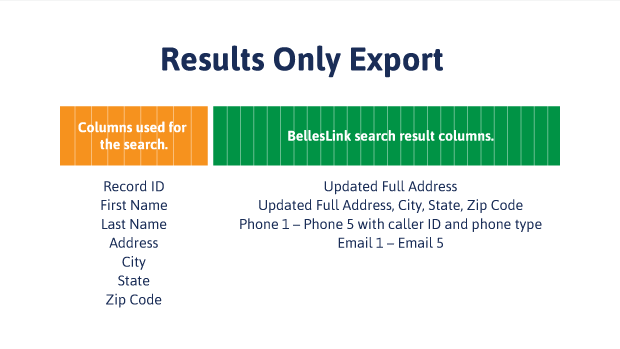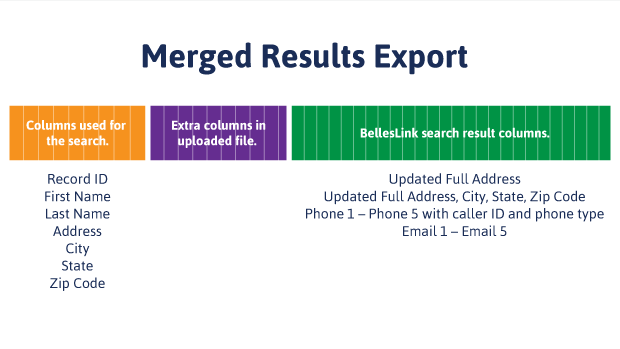The first time you get your batch people search results it can be intimidating. You’re looking a spreadsheet with a couple dozen columns, filled with data, and it’s difficult to tell what data is in which column.
If you have felt this way, don’t worry. This post will help you make sense of all those columns. No one is born knowing how to work with spreadsheets, it just takes a little guidance and practice.
Let’s get started.
Batch People Search Results Export
If you’re going to use your batch search results outside of BellesLink you’ll need to export a file. There are two types of exports, both will give you a .CSV file.
CSV stands for comma separated values. It’s a simple type of spreadsheet which can be read by any spreadsheet software, such as Microsoft Excel, Apple Numbers, and Google Sheets. A CSV file cannot contain text formatting or multiple sheets like an Excel file. It is plain black and white, but it’s the best format for importing and exporting.
Note, when you upload your batch file to be searched, it also has to be in the .CSV format. If you bought a list it will most likely come to you as a .CSV and any spreadsheet software you use can export a file in that format.
Two Types of Batch Search Exports
When exporting your batch search results from BellesLink you can choose either a Results Only export or a Merged Results export. Let’s take a look at what makes each export different and talk about which you should use.
Results Only Export
The CSV file you get from a Results Only export will contain thirty-eight columns, divided between the data searched and the results that come back.

The first seven columns will be the information use for the search. This includes a first name, last name, address, city, state, and zip code. This information came from the file you uploaded to BellesLink. The first column is always a Record ID, a unique identifying number for that search record. You can include your own record ID with your uploaded file. If you don’t include one, BellesLink will create one in your results file.
The next thirty-one columns will be the information that came back as search results. These columns, and this data, has been appended to the search inputs you uploaded, to create your results file.
- Updated Full Address – If our database has a more recent address than the one you searched it will be appended here.
- Updated address
- Updated state
- Updated city
- Update zip code
- Phone 1–Phone 5 – Up to five phone numbers are included with each search. The data return for each number includes the following columns.
- Phone number
- Caller ID
- Phone Type – landline or wireless
- Email 1– Email 5 – Up to five emails are returned with each search
I’ve created an example Google Sheet with color-coded columns so you can see the layout of the batch search results more easily.
When To Use a Result Only Export
If you are export your batch result to use in another software, such as a CRM or sales dialer, then a Result Only export will be the cleanest way.
Now let’s take a look at the Merged Results Export and when you use that.
Merged Results Export
Every other batch search service requires you to use a spreadsheet template which limits the columns in your file to only those that are required for the search, first name, last name, address, city, state, and zip, BellesLink does not. Your file can have extra columns.
When you upload you file, you will choose the columns from your file to be used for each required search column, through our upload wizard. If your file has extra columns, such as additional information about the person or property you’re searching, they will be ignored. But, BellesLink keeps a copy of your complete file, with all its columns and data, in your account.

When you export your batch results, you can choose to have the results merged into your original file, with all its columns and data. This created an extra section of columns in the .CSV file you get from the export.
A merged results exported file will include:
– The seven columns of search inputs.
– All the extra columns from your original file.
– The thirty-one columns of search results including updated address, phone numbers, and emails.
I’ve created an example Google Sheet with color-coded columns so you can see the layout of a merged export more easily.
When To Use a Merged Export
If you have a master spreadsheet that includes many columns of data and you don’t want to risk creating errors by deleting all the columns that are not required for a batch search, then upload your entire spreadsheet and use the merged export option.
All the data in your master spreadsheet will be saved and returned to you, with the results merged. Merging spreadsheets is a difficult and error-prone process when done manually. Using the Merged Export eliminates the risk of mismatching your data.
Ok, that’s a detailed look at batch search results and the two ways your can export your data. Watch the tutorial video and download the examples spreadsheets to get more details.
If you can any questions about batch search results, contact us by phone or email.

